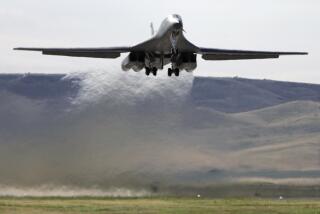Pilots Are Blamed in Wellstone Crash
WASHINGTON — The crash that killed Minnesota Sen. Paul Wellstone last year was caused by a series of avoidable mistakes as two charter pilots with inferior flying skills prepared to land on a snowy day, federal investigators concluded Tuesday.
Pilot Richard Conry and co-pilot Michael Guess twice failed to align their twin-engine turboprop on the proper course for an instrument landing in Eveleth, Minn., and then allowed their airspeed to drop to dangerously low levels. That caused the King Air A100 to stall and plummet into the woods, killing all eight aboard, the National Transportation Safety Board determined.
“This was a tragic accident that really shouldn’t have happened,” said safety board chief Ellen G. Engleman. “It became almost like a domino effect.”
Wellstone was a popular Democrat in a tight race, and his death might have played a role in enabling Republicans to regain the Senate.
The accident could lead to closer scrutiny of on-demand charters and to technological improvements that increase safety for politicians, business executives and others who frequently fly unscheduled routes on small commercial planes.
In a unanimous vote, the safety board urged the Federal Aviation Administration to tighten inspections of on-demand charter companies to improve pilot training and in-flight procedures. It also recommended that the FAA and NASA create a special technical panel to study the feasibility of “low airspeed alert systems.” Primarily for small planes, such systems would automatically warn pilots of conditions that could precede a disastrous stall.
An FAA spokesman defended the agency’s oversight of the charter company, Aviation Charter Inc. He said the safety board recommendations, which were not binding, would be closely studied.
Although the weather was less than ideal on the morning of the Oct. 25, 2002, crash, investigators concluded that ice on the wings was not a factor. Less than three minutes of the 50-minute flight from St. Paul, Minn., were under conditions that could have caused moderate icing. Moreover, the plane had de-icing equipment.
However, the aircraft was not required to be equipped with a cockpit voice recorder or a flight data recorder, which could have greatly aided investigators. Separately, the safety board was considering recommendations that would widen the types and uses of transportation recorders.
The senator, his wife and a daughter were headed to the funeral of a supporter, accompanied by three campaign workers.
Records show that the pilot initially balked at making the flight, after receiving an early-morning weather briefing. Skies were overcast with light snow and icing conditions at certain altitudes. Conry later changed his mind about flying, but Engleman said there was “no indication” that he was pressured.
Even if there was no overt pressure, some independent experts said the charged environment of a close political race might have been enough to prompt miscalculations.
“You can look back at any number of accidents and find pressure to complete the mission,” said Warren Morningstar of the Aircraft Owners and Pilots Assn., which represents private pilots. “It takes a very disciplined individual to be able to say, ‘I’m sorry, sir, it’s not safe and we’re not going to fly.’ And it’s never black-and-white. It’s never absolutely unsafe. There’s always a gray area.”
Records show that Conry was not an assertive pilot and that he often allowed his copilots to do most of the flying. The safety board concluded that both pilots had “previously demonstrated potentially serious performance deficiencies during flight operations, consistent with below-average flight proficiency.”
Investigators also found shortcomings on the part of the charter company, citing the inadequate training of pilots and several procedural deficiencies that could affect flight operations. A spokesman for Aviation Charter did not return a call for comment.
Shortly before the plane was cleared to land at Eveleth, a controller asked the pilots whether they had worked out a plan in case they missed the runway on their first approach. One of the pilots answered that he hoped it wouldn’t happen, but that if it did, they’d figure it out.
With the aid of cockpit instruments, the pilots were supposed to home in on a navigational beacon that would guide them to the runway. They missed on the first try, flying too far north, investigators said. The pilots swung back around and crossed the signal’s path, but this time they drifted too far to the south.
Early in the approach, the crew had neglected to lower the gear and make other standard preparations for landing.
With only minutes to their expected landing, the pilots were apparently still trying to spot the runway, investigators said.
They allowed their airspeed to drop well below what the plane’s manufacturer and the charter company recommended for a landing. That put the plane at risk of losing lift. But the pilots flew on for nearly a minute at low speeds before the plane stalled, investigators said.
The plane had a warning device that would have alerted the pilots to an impending stall. But John Clark, the safety board’s head of aviation safety, said a low-speed warning, had it been available, would have sounded earlier and given the pilots more time to avoid a calamity.
“We want [the FAA and NASA] to take a good, hard look at this and see if there is a way we can take the edge off this problem,” said Clark.
More to Read
Sign up for Essential California
The most important California stories and recommendations in your inbox every morning.
You may occasionally receive promotional content from the Los Angeles Times.










